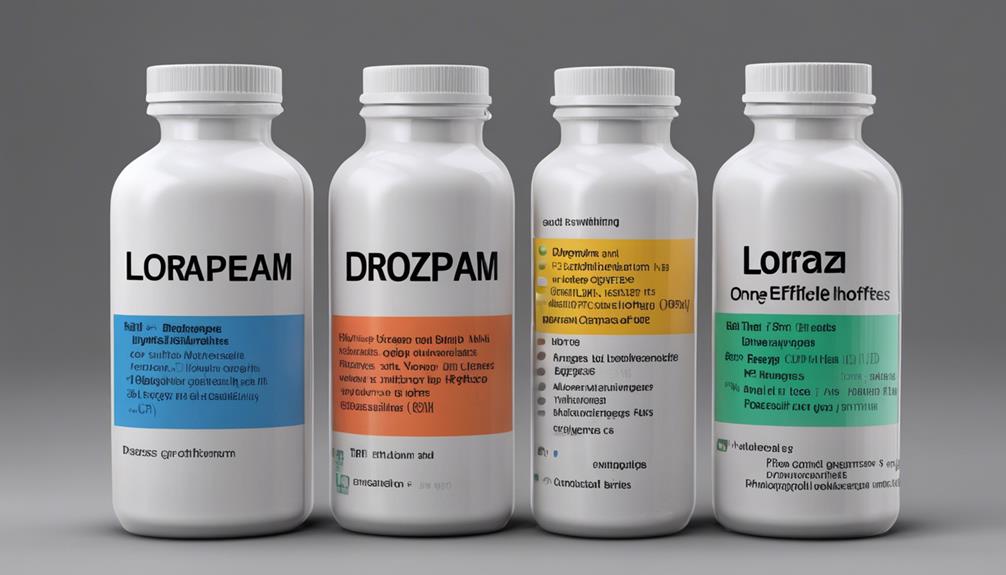When a person is approaching the end of their life, there are four key medications that can effectively manage symptoms. Acetaminophen can help ease mild to moderate pain and can be used in combination with other drugs for better relief. Haloperidol is used for managing agitation and delirium, and works quickly when administered in various ways. Lorazepam assists with anxiety by enhancing certain brain effects, which is especially crucial in palliative care situations. Lastly, Morphine is crucial for pain relief in end-of-life care and is available in different forms. Understanding these medications can significantly improve patient comfort and quality of care.
Key Takeaways
- Acetaminophen: Common for mild to moderate pain, cornerstone in palliative care.
- Haloperidol: Manages agitation and delirium, quick onset of action.
- Lorazepam: Rapid anxiety relief, crucial in end-of-life psychological distress.
- Morphine: Vital for pain relief, various formulations for comfort in hospice care.
- Dosing Considerations: Adhere to guidelines, monitor side effects, adjust for patient conditions.
Acetaminophen for Pain Management
When managing pain in end-of-life care, acetaminophen, also known as paracetamol, serves as a common and effective over-the-counter option. In palliative care, where the focus is on enhancing quality of life and providing comfort, pain management is paramount. Acetaminophen is a cornerstone in this approach, helping to alleviate mild to moderate pain that individuals may experience as they near the end of their journey. Its use in drug therapy is well-established, and when combined with other medications, it can offer enhanced pain relief, promoting a sense of ease for patients in their final stages.
End-of-life situations can be challenging, and acetaminophen plays an essential role in providing comfort to those in need. Unlike NSAIDs, acetaminophen has minimal anti-inflammatory effects, making it a preferred choice in certain scenarios. Additionally, its ability to reduce fever can be particularly beneficial, as fever can often be distressing for individuals in their final days. In these instances, acetaminophen stands as a reliable ally in the holistic care of individuals approaching the end of life.
Haloperidol for Agitation

Haloperidol, a commonly utilized medication in palliative care, effectively manages agitation and delirium in terminally ill patients. When individuals near the end of life, they may experience distressing symptoms like restlessness, confusion, or aggressive behavior. Haloperidol plays an important role in alleviating these manifestations of agitation and delirium, promoting a sense of calm and comfort for patients during this sensitive time.
As a first-line treatment for agitation in end-of-life care, haloperidol is favored for its quick onset of action and effectiveness in addressing challenging symptoms. Whether administered orally, intravenously, or subcutaneously, this medication aids in controlling behaviors such as restlessness, aggression, and hallucinations that can arise in individuals facing terminal illnesses.
In some cases, healthcare providers may combine haloperidol with other medications like midazolam and morphine to create a holistic approach to managing complex symptoms at the end of life. This combination can provide a more thorough and tailored care plan to ensure the comfort and well-being of patients experiencing agitation and delirium in palliative care settings.
Lorazepam for Anxiety
In palliative care settings, a commonly utilized medication for managing anxiety is lorazepam, a benzodiazepine known for its sedative and anxiolytic properties. Lorazepam acts by enhancing the effects of gamma-aminobutyric acid (GABA) in the brain, providing a calming effect. This medication has a rapid onset of action, making it effective for quickly alleviating anxiety in patients. It is often prescribed in end-of-life care to ease psychological distress and promote comfort in terminally ill individuals. However, dosage adjustments are essential, especially for elderly or debilitated patients, to prevent oversedation and adverse effects.
| Emotions Evoked | Reasons for Use | Benefits |
|---|---|---|
| Comfort | Anxiety Relief | Sedation |
| Calmness | Agitation Control | Anxiolytic Properties |
| Peacefulness | Improved Sleep | Rapid Onset of Action |
| Security | Psychological Support | Short Duration |
| Relief | Enhanced Well-being | Reduced Distress |
Morphine for Palliative Care

Morphine is a vital pain-relieving medication often used in end-of-life care to help manage severe discomfort. It works by attaching to specific receptors in the brain and spinal cord, easing the sensation of pain.
When using morphine, it's important to carefully adjust the dosage to find the right balance between pain relief and potential side effects.
Morphine Pain Relief
When managing severe pain in palliative care, a crucial opioid analgesic plays a pivotal role in ensuring comfort and quality of life for patients approaching the end of life. Morphine, a commonly used medication in palliative care, acts on the central nervous system to relieve pain by binding to opioid receptors in the brain and spinal cord. It is available in various formulations, including immediate-release and sustained-release, tailored to meet individual needs. The dosage of morphine is carefully titrated to balance pain control with potential side effects like respiratory depression and constipation. Morphine, when used appropriately, is a cornerstone medication for ensuring comfort and improving the quality of life for patients in hospice and palliative care settings.
| Benefits of Morphine Pain Relief |
|---|
| Effective pain management |
| Improved quality of life |
| Tailored dosage for individual needs |
Dosage Considerations
Considering individual patient responses and pain levels, dosage adjustments for morphine in palliative care are essential for optimizing pain relief while minimizing side effects. When administering morphine for end-of-life care, the following dosage considerations are critical:
- Start with lower initial doses to reduce side effects.
- Gradually increase doses based on pain relief needs.
- Utilize subcutaneous administration for continuous pain management.
- Address breakthrough pain with immediate-release morphine in addition to sustained-release formulations.
Dosing Considerations for Acetaminophen

When considering dosing acetaminophen in end-of-life care, it's important to adhere to the recommended guidelines of 650-1000 mg every 4-6 hours for pain relief.
Safety precautions like not exceeding 3000-4000 mg daily can help prevent liver toxicity, especially in patients with compromised liver function.
Monitoring the effectiveness of acetaminophen by regularly evaluating pain intensity and patient response is key to ensuring top-notch symptom control.
Acetaminophen Dosing Guidelines
In managing pain and fever in end-of-life care, understanding the dosing guidelines for acetaminophen is essential. Here are some key points to bear in mind:
- The recommended oral dose for adults is 325-1000 mg every 4-6 hours, not exceeding 4000 mg in 24 hours.
- In elderly patients or those with liver disease, the maximum daily dose should be reduced to 3000 mg to prevent toxicity.
- Acetaminophen comes in various forms like tablets, capsules, liquid suspensions, and intravenous preparations to meet different patient needs.
- Due to its minimal side effects within recommended doses, acetaminophen is a preferred choice for pain management in palliative care, providing effective relief for patients in end-of-life situations.
Safety Precautions for Acetaminophen
Adjusting acetaminophen dosages is crucial in end-of-life care, especially when managing patients with liver dysfunction or reduced renal function. In these cases, lower doses or extended dosing intervals may be necessary to prevent potential harm.
When liver function is compromised, the maximum daily dose of acetaminophen is often limited to 3-4 grams to avoid liver toxicity. Continuous patient monitoring is vital to guarantee the medication is effectively managing pain without causing harm. Regular liver function tests should be conducted to assess the impact of acetaminophen on the liver over time. If liver impairment is severe, alternative pain management options should be considered to prevent further damage.
Monitoring Acetaminophen Effectiveness
For optimal pain management in end-of-life care, we carefully monitor the effectiveness of acetaminophen while considering dosing adjustments based on individual liver function. When monitoring acetaminophen, we focus on several key aspects:
- Pain Management: Evaluate the level of pain relief provided by acetaminophen.
- Liver Function: Take into account the individual's liver health to determine appropriate dosing.
- Overdose Prevention: Guarantee that the maximum daily dose of 4 grams isn't exceeded to prevent liver damage.
- Adverse Effects: Keep an eye out for any unwanted side effects that may occur while taking acetaminophen.
Monitoring Haloperidol Effectiveness
Consistently evaluating changes in behavior, perception, and cognitive function in terminally ill patients is essential for monitoring the effectiveness of haloperidol in end-of-life care. When monitoring haloperidol, healthcare providers focus on its impact on symptoms such as psychosis, agitation, and delirium. By observing these symptoms, we can assess how well haloperidol is working to improve the patient's comfort and manage end-of-life symptoms effectively.
To track the effectiveness of haloperidol, it's important to monitor not only the severity of symptoms but also the duration of its effects. Additionally, observing any potential side effects is critical in ensuring the medication is well-tolerated. Regular assessments are key to adjusting the dosage and considering alternative medications if necessary. Ultimately, the goal of monitoring haloperidol effectiveness is to provide the best possible care for terminally ill patients, ensuring their comfort and quality of life during this challenging time.
Potential Side Effects of Lorazepam

Monitoring potential side effects of lorazepam is essential in ensuring safe and effective medication management in end-of-life care. When using lorazepam in palliative settings, healthcare providers must be vigilant for adverse effects to maintain optimal patient care. Here are four key points to take into account regarding the potential side effects of lorazepam:
- Adverse Effects: Lorazepam can induce various adverse effects such as hiccups, disinhibition, and prolonged anterograde amnesia. These side effects can impact the patient's quality of life and overall well-being.
- Symptom Management: While lorazepam is beneficial for managing symptoms like anxiety and agitation in end-of-life care, the risk of adverse effects must be carefully balanced. Close monitoring is crucial to ensure the medication's effectiveness without compromising patient safety.
- Patient Safety: Understanding and addressing potential side effects of lorazepam contribute to safe and effective medication management in palliative care. Regular assessments and communication with patients are essential to mitigate any negative outcomes.
- Optimal Care: By being aware of the potential side effects of lorazepam, healthcare providers can deliver comprehensive and compassionate care to patients in end-of-life situations.
Benefits of Morphine in End-Of-Life Care

Morphine is a powerful pain reliever commonly used in end-of-life care scenarios. It helps manage severe pain, aids in sedation management, and controls respiratory symptoms, providing comfort to patients.
Understanding its benefits is vital in ensuring patients receive the necessary relief and support during their final days.
Morphine Pain Relief
In end-of-life care, the benefits of utilizing morphine for pain relief are significant. Here are four key points to ponder when using morphine in end-of-life care:
- Effective Pain Relief: Morphine, as an opioid analgesic, binds to specific receptors in the brain and spinal cord, providing effective pain relief for terminally ill patients.
- Enhancing Quality of Life: Morphine plays a pivotal role in alleviating pain and promoting comfort, ultimately enhancing the quality of life for those in end-of-life care.
- Individual Dosage Adjustments: Due to variations in response and tolerance, dosage adjustments may be necessary to guarantee optimal pain control and minimize side effects.
- Monitoring and Titration: Proper monitoring and titration of morphine dosage are essential to achieve the best pain management outcomes while taking into account individual needs and responses.
Sedation Management
When managing sedation in end-of-life care, the benefits of utilizing morphine as a key medication are significant. Morphine plays an essential role in providing comfort and symptom control for patients in palliative care. Its potent analgesic properties make it effective in managing severe pain, ensuring that individuals are as comfortable as possible during their final days.
Additionally, morphine is valuable in addressing distressing symptoms like dyspnea, offering significant relief to terminally ill patients. The sedative effects of morphine also help alleviate anxiety and agitation, promoting a sense of calmness and peace in those nearing the end of life.
With its rapid onset of action and versatility in managing multiple symptoms, morphine is an essential component of sedation management in end-of-life care scenarios.
Respiratory Symptom Control
Addressing respiratory symptoms in end-of-life care involves utilizing medications that effectively alleviate distress and improve comfort for terminally ill patients. When considering respiratory symptom control, morphine plays an important role in end-of-life care due to its effectiveness in managing dyspnea and air hunger. In addition to morphine, other medications such as bronchodilators and anxiolytics may be used to reduce discomfort and ease breathing. These treatments aim to provide relief when a hospice patient defies the odds, surviving longer than expected while still experiencing significant respiratory distress. Ultimately, the goal is to enhance the quality of life during the patient’s final days, ensuring comfort and dignity.
Here are four key benefits of using morphine in end-of-life care:
- Morphine is a potent opioid analgesic that helps alleviate distressing respiratory symptoms.
- It binds to opioid receptors in the central nervous system, reducing the perception of respiratory distress.
- Studies have demonstrated that morphine not only improves symptom control but also enhances patient comfort and quality of life.
- Proper dosing and titration under medical supervision are essential to optimize the benefits of morphine in providing respiratory symptom relief during end-of-life care.
Special Considerations for Acetaminophen Use

Considering the unique characteristics of acetaminophen, it is crucial to comprehend specific considerations for its use in end-of-life care. Acetaminophen is a valuable medication for managing mild to moderate pain and reducing fever in palliative care settings. It is often preferred over NSAIDs due to its lower risk of causing gastrointestinal issues in patients nearing the end of life. However, dosage adjustments may be necessary for individuals with liver problems or those who have been using acetaminophen long-term. This guarantees safe and effective pain relief while minimizing the risk of side effects. Acetaminophen can be administered via different routes such as orally, rectally, or intravenously, depending on the patient's condition and needs. Below is a table summarizing key considerations for acetaminophen use in end-of-life care:
| Consideration | Details |
|---|---|
| Dosage adjustments | Required for liver dysfunction or chronic use |
| Administration routes | Oral, rectal, or intravenous |
| Side effect risk | Lower risk of gastrointestinal bleeding |
| Pain management | Effective for mild to moderate pain |
| Patient population | Commonly used in palliative care settings |
Role of Lorazepam in Symptom Management

Lorazepam, a benzodiazepine commonly utilized in palliative care, effectively manages symptoms such as anxiety, agitation, and seizures by enhancing the brain's gamma-aminobutyric acid (GABA) effects for sedation and relaxation.
- Quick Symptom Relief: Lorazepam is rapidly absorbed orally, providing a fast onset of action, making it valuable for immediate symptom relief in palliative care settings.
- Common Side Effects: Drowsiness, dizziness, and potential respiratory depression are common with lorazepam, particularly when used alongside other central nervous system depressants.
- Dosage Adjustments: Elderly patients and those with liver or kidney issues may require dosage adjustments to prevent excessive sedation or other adverse effects.
- Careful Monitoring: Close monitoring is essential when using lorazepam for symptom management in palliative care to ensure the best effectiveness and safety for the patient.
When considering lorazepam in palliative care for symptom management, it's important to weigh its benefits against potential side effects, ensuring proper dosing and monitoring for the best outcomes in providing comfort and relief to patients.
Frequently Asked Questions
What Are 4 Medications for End-Of-Life Care?
Four medications commonly used in end-of-life care include morphine, midazolam, haloperidol, and lorazepam. These drugs help manage pain, agitation, and anxiety to guarantee comfort for patients. Shifts in dosages and administration routes may occur for best effectiveness.
What Are the Four Essential Palliative Drugs?
Oh, the wonders of essential palliative drugs! Acetaminophen soothes pain and fevers, haloperidol calms delirium, lorazepam eases anxiety, and morphine reigns for severe pain. These meds, pivotal in end-of-life care, bring comfort to those in need.
What Drugs Are Given in the Last Stage of Death?
In the final stage of death, we commonly administer morphine, midazolam, haloperidol, and lorazepam to manage pain, anxiety, agitation, and delirium. Adjusting dosages as needed and switching to subcutaneous delivery optimizes comfort for patients nearing the end of life.
What Medication Is Used for End of Life Secretions?
We manage end-of-life secretions with medications like glycopyrrolate and scopolamine. These drugs quickly dry up secretions, offering comfort for patients and families. Proper care in this area enhances the quality of life during this challenging time.
Conclusion
To sum up, these four pivotal drugs play a vital role in providing comfort and relief to individuals nearing the end of life. While managing pain, agitation, anxiety, and providing palliative care, these medications help guarantee a peaceful and dignified shift.
It's important to collaborate closely with healthcare professionals to determine the appropriate dosages and monitor for any potential side effects. By utilizing these medications effectively, we can help enhance the quality of life for those in need during their final days.









